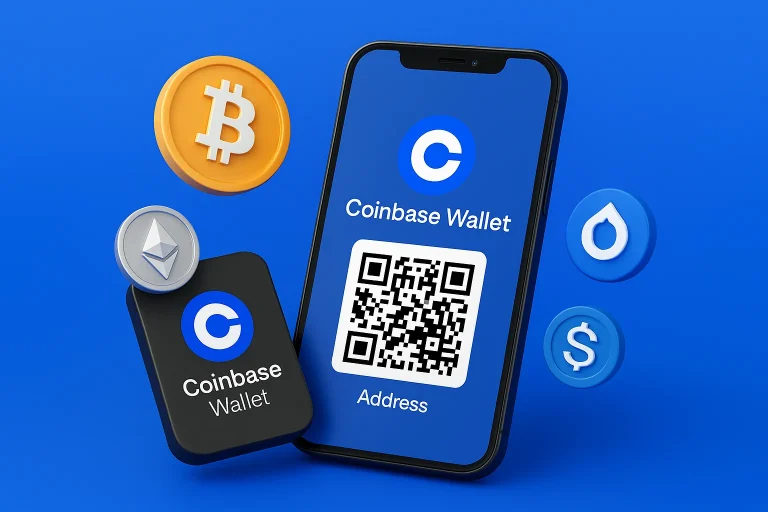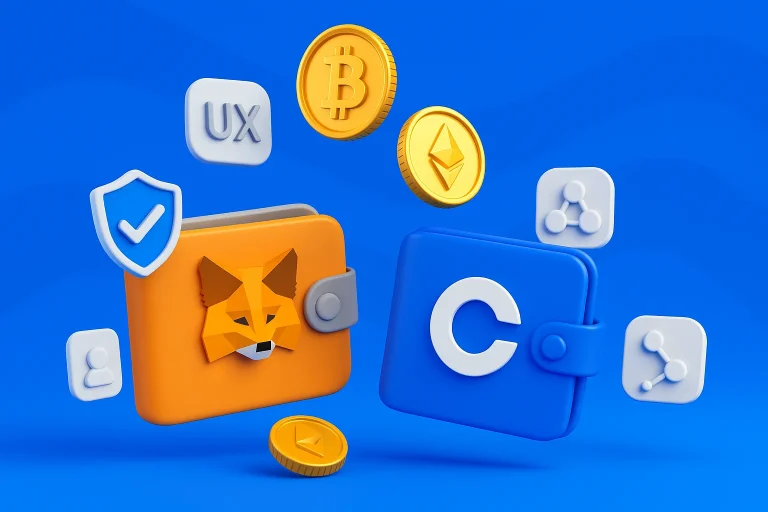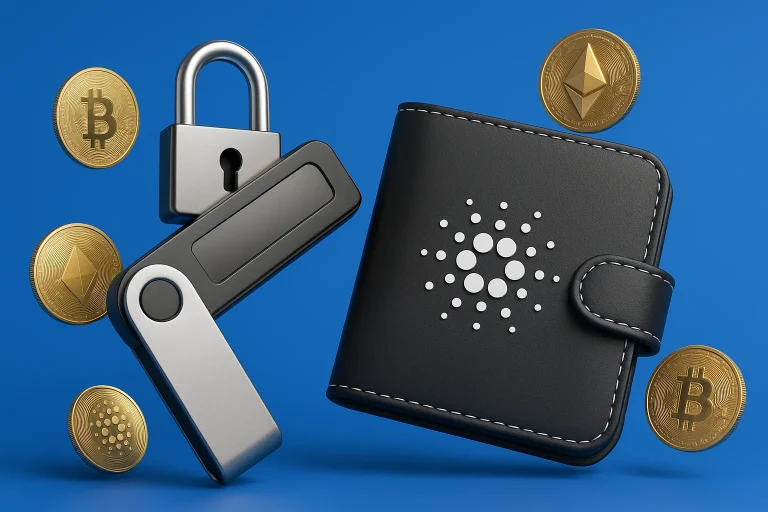If you’ve ever sent or received cryptocurrency, you’ve probably seen an extended mix of letters and numbers. That’s your wallet address, the digital “home” where your crypto is stored.
In crypto, accuracy matters. One small mistake in an address can direct your funds to the wrong location, and there’s no way to recover them. That’s why understanding how wallet addresses work is crucial for keeping your assets secure.
In this guide, we’ll explain what a wallet address is, how it functions, and the best security practices to protect your crypto. By the end, you’ll be ready to send and receive digital assets with confidence.
Table of contents
What Is a Wallet Address?
A wallet address (also known as a cryptocurrency wallet address) is a unique string of alphanumeric characters that identifies a specific cryptocurrency wallet on the blockchain.
Think of it like “an email address for crypto”; instead of sending messages, you send and receive digital currencies such as Bitcoin, Ethereum, or stablecoins. Many crypto users rely on these identifiers every day to manage and secure their funds.
When someone sends crypto to your address, the blockchain records the transaction permanently. Each cryptocurrency (e.g., BTC, ETH) uses its own address format and network rules. These are known as unique address formats across different blockchains.
Key Factors to Consider
1. Your Wallet Address Represents Your Digital Identity
On the blockchain, your wallet address serves as a unique identifier, much like a personal ID. It identifies you as the sender or receiver in every crypto transaction and helps confirm ownership of funds without revealing your name or personal data.
2. Each Cryptocurrency Has Its Own Address System
There’s no universal format for all coins. Bitcoin, Ethereum, and other blockchains use their own standards and encoding rules, meaning every network manages addresses differently. Using the correct wallet address is essential to prevent loss.
3. Wallet Addresses Are Created Automatically
You don’t need to generate one manually. Every time you create a new wallet, it automatically provides you with one or more wallet addresses ready for use. Some wallets even refresh your address for privacy, an important detail when understanding wallet addresses.
4. You Can Safely Share Your Wallet Address
It’s perfectly safe to share your crypto wallet address when someone wants to send you funds. It doesn’t give them access to your assets; it simply tells the blockchain where to deliver the transaction. This is also known as your public wallet address.
5. Wallet Addresses Help Ensure Transparency
Every crypto transaction linked to a wallet address is publicly recorded on the blockchain. This makes the system transparent and verifiable; anyone can confirm that a payment was made, even if they are not aware of the wallet’s owner. These blockchain transactions build trust across decentralized systems.
How Does a Wallet Address Work?
A wallet address is your unique location on the blockchain where crypto can be sent or received. It doesn’t store coins directly; instead, it references your balance and transaction history, which are recorded on the blockchain.
1. Wallet Addresses Are Built from Cryptographic Keys
When you create a crypto wallet, it generates two important keys:
- Public key: used to create your wallet address.
- Private key: used to access and control your crypto.
Together, these public and private keys safeguard your crypto assets and interact with decentralized applications and smart contracts to execute automated, trustless transactions on supported blockchains.
2. Sending Crypto
When you send crypto:
- You enter the recipient’s wallet address.
- Your private key signs the transaction digitally (this proves it’s really you).
- The blockchain network checks your signature and confirms the transfer.
Once approved, the transaction is recorded permanently on the blockchain ledger. Typing errors or incorrect addresses during this process can cause irreversible losses.
3. Receiving Crypto
When someone sends crypto to your wallet address:
- The network broadcasts the transaction to the blockchain.
- Miners or validators confirm it.
- The funds appear in your wallet balance once confirmed.
You don’t need to take any action; your wallet automatically detects the incoming transaction, even when handling multiple transactions.
Public Keys vs. Private Keys: What’s the Difference?
Public Key / Wallet Address |
Private Key |
|
|---|---|---|
| Purpose | Used to receive cryptocurrency and show wallet activity on the blockchain. | Used to access, manage, and send funds from your wallet. |
| Visibility | Public can be safely shared with others. | Private, thus it must be kept secret. |
| Function | Acts as a digital “address” where others can send crypto. | Acts as your digital “password” to authorize transactions. |
| Ownership Proof | Verifies that funds belong to your wallet. | Proves that you are the rightful owner and can control the assets. |
| Security Risk | Sharing is safe; it doesn’t expose your crypto. | If exposed, anyone can take full control of your funds. |
| Recovery | Can be regenerated from your private key. | Can’t be recovered if lost, leading to permanent loss of access. |
| Storage | Automatically stored in your wallet and visible on explorers. | Encrypted within your wallet, it should be backed up securely (e.g., via a seed phrase). |
Types of Wallet Addresses
Each cryptocurrency has its own address format and set of rules. Understanding these formats helps you identify the correct address for each transaction and avoid sending funds to the wrong network.
1. Bitcoin Wallet Addresses (BTC)
Bitcoin uses three main types of wallet addresses, each developed at different stages of the network’s evolution:
Legacy (P2PKH):
- These are the oldest Bitcoin addresses, starting with “1”.
- All wallets and exchanges still support them, but have higher transaction fees.
SegWit (P2SH):
- These addresses begin with “3” and were introduced to reduce transaction size and cost.
- They’re compatible with most modern wallets.
Bech32 (Native SegWit):
- The newest and most efficient Bitcoin address format.
- It starts with “bc1”, offers lower fees, and is less prone to typing errors.
Example of a Bitcoin address: bc1qar0srrr7xfkvy5l643lydnw9re59gtzzwf5mdq
2. Ethereum Wallet Addresses (ETH)
Ethereum wallet addresses always follow the same pattern:
- They start with “0x” and contain 40 characters made up of letters (a–f) and numbers (0–9).
- This format is used not only for ETH but also for all ERC-20 tokens, such as USDT, LINK, and MATIC.
Example of an Ethereum address: 0x32Be343B94f860124dC4fEe278FDCBD38C102D88
Because all ERC-20 tokens use the same network, you can receive them at the same address. Ensure your wallet supports the token before sending.
3. Exchange Wallet Addresses
When you use a centralized exchange (like Binance, Coinbase, or Kraken), your crypto is held in an exchange wallet.
- The exchange creates and manages the wallet address on your behalf.
- You can deposit and withdraw crypto using this address, but you don’t control the private keys.
- It’s convenient for trading but less secure for long-term storage. For better protection, consider moving funds to digital wallets you control.
4. Self-Custody Wallet Addresses
Self-custody wallets (also called non-custodial wallets) give you complete control of your private keys.
- You can create, manage, and back up your own wallet address.
- Examples include MetaMask, Trust Wallet, Ledger, and Trezor.
- Suit users who prioritize security and independence.
These wallet providers allow users to retain control of their assets without third-party interference.
5. HD Wallet Addresses
HD (Hierarchical Deterministic) wallets automatically generate a new wallet address each time you receive crypto. This prevents others from linking your transactions and improves privacy.
With these, you can create multiple addresses for privacy and organization.
6. Multi-Currency Wallets
Some modern wallets, such as Exodus or Coinomi, support multiple blockchains within a single app.
- You can hold Bitcoin, Ethereum, and other coins, each with its own wallet address format.
- This makes managing different assets easier while keeping them separate on their respective networks.
How to Find Your Wallet Address
1. Mobile Wallets (e.g., Trust Wallet, MetaMask Mobile)
Mobile wallets make it simple to access your crypto address in just a few taps.
- Open your wallet app (Trust Wallet, MetaMask, or similar).
- Select the cryptocurrency you want to receive (e.g., Bitcoin, Ethereum).
- Tap “Receive”, your wallet will display a QR code and a string of characters.
- Copy or scan the address. You can share it with the sender or paste it into an exchange to deposit funds.
2. Browser Wallets (e.g., MetaMask Extension)
If you’re using a browser extension wallet like MetaMask:
- Click on the MetaMask icon in your browser toolbar.
- Under your account name, you’ll see a shortened wallet address (like 0x32Be…D88).
- Click to copy it; it’s your Ethereum and ERC-20 token address.
- You can paste it anywhere you need to receive crypto.
Note: MetaMask uses the same address for ETH and compatible tokens such as USDT, MATIC, or LINK.
3. Hardware Wallets (e.g., Ledger, Trezor)
For maximum security, hardware wallets store your private keys offline.
- Connect your Ledger or Trezor device to your computer or mobile device.
- Open the official companion app (Ledger Live or Trezor Suite).
- Select the cryptocurrency account (e.g., Bitcoin).
- Click “Receive”, then verify the address shown on your hardware device.
- Copy or scan the verified address from the app.
Always verify the address directly on your device’s screen to ensure it hasn’t been tampered with by malware.
4. Exchange Wallets (e.g., Binance, Coinbase, Kraken)
Centralized exchanges generate wallet addresses for users to deposit funds.
- Log in to your exchange account.
- Go to your “Wallet” or “Deposit” section.
- Choose the crypto you want to deposit (e.g., BTC).
- The exchange will display your deposit address and a QR code for you to scan.
- Copy and use this address to send crypto to your exchange wallet.
5. Finding Addresses in Multi-Currency Wallets
Apps like Exodus or Coinomi support multiple coins and tokens.
- Open the app and select your crypto asset.
- Tap “Receive” to display your wallet address and QR code.
- Each supported asset will have a different address format; ensure you use the correct one for each transaction.
How to Create and Manage Wallet Addresses
1. Creating a New Wallet Address
When you set up a crypto wallet, it automatically generates one or more wallet addresses for you, no coding or technical setup required.
If you want a separate address for specific transactions or improved privacy:
- Open your wallet and choose the cryptocurrency.
- Tap or click “Receive” or “New Address.”
- A unique address (and QR code) will appear; copy or scan it.
For hardware wallets, use the companion app (such as Ledger Live or Trezor Suite) and verify the address directly on your device’s screen before sharing it. This ensures it hasn’t been altered by malware.
2. Staying Organized with Labels and Address Books
If you make frequent transactions, organization matters.
- Use labels: Tag your addresses with short, descriptive names, such as “July client payment” or “Cold storage wallet.”
- Separate sub-accounts: Some wallets allow multiple accounts to be created under a single seed phrase. Use them to divide funds (for example, between business and personal expenses).
- Address books: Save frequently used, verified addresses to avoid copy-paste errors and ensure consistent transfers.
3. Advanced Address Management Features
Modern wallets include extra tools to improve security and convenience:
- Watch-only wallets: View balances and transactions without exposing private keys, ideal for accountants or auditors.
- Multi-sig addresses: Split control between several people or devices (e.g., 2-of-3 authorization). Perfect for businesses or joint accounts. These are also used in multi signature transactions that require multiple approvals before funds can move, enhancing overall security.
- Human-readable names: Some ecosystems (like ENS or Unstoppable Domains) let you link your wallet to a simple name like yourname.eth.
- Memo or Tag fields: For coins like XRP, XLM, or BNB, always include the memo/tag shown in your deposit instructions; omitting it may delay or result in the loss of your funds.
Security Tips for Wallet Addresses
Protecting your wallet address goes beyond avoiding typing mistakes. It’s about building safe habits that keep your crypto out of reach from scams, phishing, and accidental loss. Here’s how to do it right:
Use Trusted Wallets and Official Apps Only
Always download wallets from official websites or verified app stores. Avoid downloading from or sharing third-party links in emails and chats. Many fake apps are designed to steal your private keys or show a fake address.
If you’re unsure, cross-check the developer name or look for the app’s official verification link on the project’s website.
Verify Before Every Transaction
Before sending or receiving crypto, confirm:
- The address format matches the correct blockchain (e.g., “0x” for Ethereum, “bc1” for Bitcoin).
- The address hasn’t been replaced by clipboard malware; paste, then compare the first and last few characters.
- When using hardware wallets, verify the address displayed on your device screen before approving a transaction.
A few extra seconds of checking can save you from permanent loss.
Stay Alert for Scams and Phishing
Scammers often imitate wallet interfaces, exchanges, or even send fake “security updates.”
- Never click on suspicious links that ask you to “verify” your wallet.
- Avoid connecting your wallet to unknown decentralized applications (dApps) or websites.
- When in doubt, verify the domain manually; even one wrong character can lead to a phishing clone.
FAQ
Yes. Most wallets (especially HD wallets) let you generate many addresses from the exact seed phrase, so you can use different addresses for privacy or bookkeeping while still controlling them all.
If the address belongs to a different person on the same blockchain, only that address’s owner can return the funds; there’s no automatic recovery.
Yes, all transactions tied to an address are publicly visible on the blockchain, allowing anyone to view both incoming and outgoing transactions. Linking that address to your real identity requires extra data (KYC, IP logs, public postings), but it’s possible, so use separate addresses and privacy tools if you don’t want transactions traced back to you.
Generally, you don’t need to type addresses by hand (copy/paste or use a QR code is best), but format rules do matter. Some formats are case-insensitive (e.g., Bitcoin legacy, many others). Ethereum addresses are typically lowercase but may use mixed-case as a checksum (EIP-55) to detect typos. Always use wallet/app copy-paste and let the software validate the address before sending.
No, blockchain addresses themselves don’t expire. However, some services or exchanges may issue temporary or rotating deposit addresses. Therefore, always use the latest deposit address displayed in your exchange or merchant interface and double-check it before sending.
Final Thoughts
“What is a wallet address?” is more than just a common crypto question; it’s the foundation of how digital currencies move and stay secure. A wallet address acts as your unique ID on the blockchain, allowing you to send and receive crypto safely anywhere in the world.
Whether you’re new to digital wallets or experienced, following best practices will help ensure your funds remain safe.




